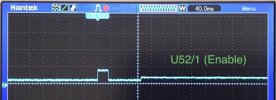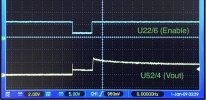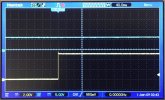There are several regulators dotted around the main board, some linear and some switch-mode.
Yes, and there's 40V (or ±20V) generated for some reason. The PSU outputs 12.3V and 6.7V (the "6.7V" output varies somewhat, actually appearing to go up with increased load).
Investigation Update
I'm continuing to document this in the hope that many eyes might spot something – I'm pretty stumped at the moment.
U52 gets its input voltage from U22, which is an Alpha Omega AOZ1073AI 3A buck (voltage lowering) SMPS (
equivalent datasheet). Pretty amazing, considering it's an 8-pin SOIC.




The bottom (yellow) trace is the 5V rail to the HDD. If you look at the trace for U52's input voltage (U52/2) you see it takes a dip just when U52 is supposed to turn on. The input voltage to U22 is OK (U22/2), but U22's enable pin goes low at the critical time (U22/6).
I don't know what's driving U22/6. I presume it's a micro I/O, but why should it turn off? It's weird. With the HDD not connected, the enable remains high.
For reference, below is for a "good" HDR, U22/6 and U52/4.

Having slept on the problem, I think the way forward is to lift U22/6 (the enable pin) and see what's what. Is the apparent shut-down for real, or is it some kind of back-drive? What if I tie it permanently high?
This is not clear though, there is still the restart to explain. The unit reboots the moment the HDD power comes up, and that could be the reason for the shut-down on U22/6 (although I would then expect the leading edge to be coincident with the trailing edge on U52/1). If I isolate U22/6 and pull it high, and the reset still occurs, I will have been looking in the wrong place!







